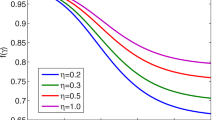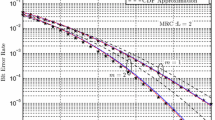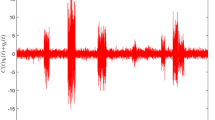Abstract
Channel estimation at the receiver side is essential for adaptive modulation schemes, prohibiting low complexity systems from using variable rate (VR) and/or variable power transmissions. This problem can be solved using variable-rate M-QAM modulation scheme for communications over fading channels in the absence of channel gain estimation at the receiver. It is shown that signal plus noise (S + N) sampling value can serve as a much better criterion compared to signal-to-noise ratio (S/N) for determining modulation order in VR systems. In this way, low complexity transceivers use VR transmissions to improve spectrum efficiency under an error performance constraint. Two kinds of fading channels: Weibull fading and α–μ fading are considered. Spectrum efficiency of (S + N) based systems are compared to that of S/N systems and the advantage of (S + N) scheme over (S/N) scheme is shown. The symbol error rates of two schemes are also studied. As an application, the proposed VR modulation scheme is shown to work with a maximum ratio combining diversity receiver.










Similar content being viewed by others
References
B. Sklar and P. K. Ray, Digital Communications, vol. 2nd, Pearson EducationUpper Saddle River, 2009.
A. S. Lioumpas and G. K. Karagiannidis, Variable-rate M-PSK communications without channel amplitude estimation, IEEE Transactions on Communications, Vol. 58, No. 5, pp. 1477–1484, 2010.
M. Abramourtz, and I. Stegun, Handbook of Mathematical Functions with Formulae, Graphs and Mathematical Tables, Chap. 7. Drover, New York, pp. 297, 1965.
W. Gautschi, Error Function and Fresnel Integrals. National Bureau of Standards, Washington, pp. 295–299, 1964. http://www.convertit.com/go/convertit/reference/ams55.asp?Res=200&Page=295.
K. Pahlavan and A. H. Levesque, Wireless Data Communications, Proceedings of the IEEE, Vol. 82, pp. 1398–1430, 1994.
E. A. Neasmith and N. C. Beaulieu, New results on selection diversity, IEEE Transactions on Communications, Vol. 46, No. 5, pp. 695–705, 1998.
S. C. L. Lye, S. E. Tan, Z. W. Siew, H. T. Yew, and K. T. K. Teo, Analysis and performance measurement of adaptive modulation and coding. IEEE International Conference on Control Systems, Computing, and Engineering, Penang, Malaysia, pp. 268–273, 2012.
K. Min and V. Tarokh, Variable-rate space-time block codes in M-ary PSK systems, IEEE Journal on Selected Areas in Communications, Vol. 21, No. 3, pp. 362–373, 2003.
F. F. Digham, M. S. Alouini and S. Arora, Variable-rate variable-power non-coherent M-FSK scheme for power limited systems, IEEE Transactions on Wireless Communications, Vol. 5, No. 6, pp. 1306–1312, 2006.
F. F. Digham and M. S. Alouini, Variable-rate non-coherent MFSK modulation for power limited systems over Nakagami fading channels, IEEE Transactions on Wireless Communications, Vol. 3, No. 4, pp. 1295–1304, 2004.
T. Konishi, M. Yokoyama, H. Vehara and H. Ito, Variable-rate MPSK coded modulation using convolutional codes over modules, Electronics and Communications in Japan (Part III: Fundamental Electronic Science), Vol. 86, No. 4, pp. 20–25, 2003.
Y. H. You, M. G. Kang, O. S. Lee, S. I. Sonh, T. W. Jang, H. K. Song, D. O. Kim, and H. S. Lim, Improved adaptive modulation and coding of MIMO with selection transmit diversity systems. Lecture notes in Computer Science—Computational and Information Science, vol. 3314, pp. 258–265, 2005.
X. Yu, Y. Xin, X. Lin and X. Chen, Performance of adaptive modulation with space-time block coding and imperfect channel state information over Rayleigh fading channels, Advances in Intelligent and Soft Computing, Vol. 135, pp. 169–176, 2012.
T. Quazi and H. J. Xu Performance analysis of adaptive M-QAM over a flat-fading Nakagami-m channel,” South African Journal of Science, vol. 107(1–2), 2011.
J. Faezah and K. Sabira, Adaptive modulation for OFDM systems, International Journal for Communication Networks and Information Security (IJCNIS), Vol. 1, No. 2, pp. 1–8, 2009.
A. Conti, M. Z. Win and M. Chiani, Slow adaptive M-QAM with diversity in fast fading and shadowing, IEEE Transactions on Communications, Vol. 55, No. 5, pp. 895–905, 2007.
B. Ellingsaeter, and T. Masang, Adaptive M-QAM signalling for dynamic spectrum access. 1th2 International Workshop on Signal Processing Advances in Wireless Communications, , San Francisco, CA, USA, pp. 16–20, June 2011.
Y. Li, and S. Kishore, Slow adaptive M-QAM under third-party received signal constraints in shadowing environments, Research Letters in Communications, 2008.
M.D. Yacoub, The α-μ distribution: A general fading distribution. IEEE International Symposium on Personal, Indoor and Mobile Radio Communications (PIMRC) 2002, Vol. 2, pp. 629–633, 2002.
I. S. Gradshteyn and I. M. Ryzhik, Tables of Integrals, Series, and Products, vol. 5th, Academic Press, New York, 1994.
A. Papoulis, Probability, Random Variables, and Stochastic Processes, Vol. 3rd, McGraw Hill, New York, 1991.
Y. G. Kim and N. C. Beaulieu, Lossless selection combining without channel state information,”Proceedings of IEEE International Conference on Communications (ICC’08) , Beijing, China, 2008. pp. 1328–1332.
Author information
Authors and Affiliations
Corresponding author
Rights and permissions
About this article
Cite this article
Bhaskar, V., Narayanan, S.R. & Sekhon, T. Performance Comparison of M-QAM Communications for (S + N) and (S/N) Channel State Estimation Schemes. Int J Wireless Inf Networks 20, 401–413 (2013). https://doi.org/10.1007/s10776-013-0216-6
Received:
Accepted:
Published:
Issue Date:
DOI: https://doi.org/10.1007/s10776-013-0216-6




